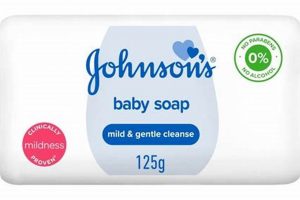The phenomenon of an infant producing clicking sounds during bottle feeding often indicates an improper latch or seal around the bottle’s nipple. This can result in the baby ingesting excessive air, leading to discomfort, gas, and potential feeding difficulties. A clicking sound, therefore, is a symptom of an underlying issue affecting the feeding process.
Addressing this issue is vital for ensuring efficient and comfortable feeding. Successful feeding promotes optimal nutrient intake, reduces fussiness, and fosters a positive feeding experience for both the infant and caregiver. Historically, observation and adjustment of feeding techniques have been primary strategies for mitigating this common challenge.
The subsequent sections will detail practical techniques for improving the infant’s latch, exploring different bottle and nipple options, and strategies for managing airflow during bottle feeding. These steps aim to eliminate the air ingestion associated with clicking sounds and promote a smoother, more comfortable feeding experience.
Techniques for Addressing Clicking Sounds During Bottle Feeding
The following techniques offer practical guidance for minimizing clicking sounds during bottle feeding and promoting a more effective latch.
Tip 1: Optimize Nipple Placement. Ensure the bottle nipple is positioned deeply within the infant’s mouth, covering the tongue. This facilitates a secure seal and minimizes air ingestion.
Tip 2: Monitor Bottle Angle. Maintain the bottle at an angle that keeps the nipple consistently filled with milk, reducing the opportunity for air to enter the nipple.
Tip 3: Burp Frequently. Interrupt the feeding process periodically to burp the infant. This helps release any air that may have been swallowed, mitigating discomfort and potential clicking sounds.
Tip 4: Evaluate Nipple Flow Rate. A flow rate that is too fast can overwhelm the infant, leading to gulping and air intake. Consider transitioning to a slower-flow nipple.
Tip 5: Assess Latch Technique. Observe the infant’s lips for proper flanging outward around the nipple. A tucked-in lip can indicate a poor seal and contribute to air ingestion. Gently encourage the lips to flange outwards.
Tip 6: Consider Different Bottle Designs. Explore bottle options specifically designed to minimize air ingestion, such as vented bottles or those with collapsible bags. These designs can reduce the vacuum created during feeding.
Tip 7: Consult with a Healthcare Professional. If clicking persists despite implementing these techniques, consulting a pediatrician or lactation consultant is advisable. They can provide personalized guidance and rule out any underlying medical conditions.
Implementing these strategies can significantly improve the infant’s feeding experience, reducing air ingestion and promoting a comfortable, efficient feeding process.
The subsequent section will address potential causes of persistent clicking despite employing these recommended techniques.
1. Proper latch technique
Proper latch technique represents a foundational element in addressing clicking sounds during bottle feeding. The clicking sound frequently originates from an incomplete seal between the infant’s mouth and the bottle nipple, allowing air to be drawn into the oral cavity during sucking. A proper latch, characterized by wide mouth opening, flanged lips, and deep nipple placement, creates a vacuum seal, thereby preventing air ingestion and the associated clicking sound. For example, an infant with a shallow latch might exhibit clicking sounds, whereas repositioning the nipple deeper into the mouth, ensuring proper lip flanging, can immediately eliminate the noise.
The significance of proper latch extends beyond merely eliminating clicking sounds. An effective latch enables efficient milk transfer, reducing the need for excessive sucking and minimizing fatigue. Conversely, an improper latch can lead to inefficient feeding, prolonged feeding times, and increased frustration for both infant and caregiver. In practical application, observing the infant’s mouth and jaw movements during feeding is crucial. A clicking sound serves as an indicator that adjustments to the latch are necessary. Gently repositioning the infant, ensuring the nipple is properly aligned with the palate, and supporting the jaw can all contribute to a more secure and effective latch.
In summary, the proper latch technique directly impacts the occurrence of clicking sounds during bottle feeding. By creating a secure seal and preventing air ingestion, a well-executed latch ensures efficient milk transfer and a more comfortable feeding experience. Recognizing the indicators of an improper latch and implementing corrective measures are crucial steps in addressing clicking sounds and promoting healthy infant feeding practices.
2. Nipple flow rate
Nipple flow rate plays a pivotal role in mitigating clicking sounds during bottle feeding. An inappropriate flow rate can disrupt the infant’s sucking coordination, leading to air ingestion and the subsequent production of clicking noises. Selecting the correct flow rate is therefore essential for optimizing feeding efficiency and comfort.
- Flow Rate and Air Ingestion
A nipple with a flow rate that is too rapid can overwhelm the infant, compelling rapid gulping to manage the milk supply. This rapid intake increases the likelihood of swallowing air alongside the milk, contributing to the clicking sound as the infant attempts to manage the excess air. Conversely, a flow rate that is too slow might lead to frustration and vigorous sucking, potentially collapsing the nipple and creating a vacuum, which also promotes air ingestion.
- Developmental Appropriateness
Nipple flow rates are typically categorized by age, reflecting the developing sucking strength and coordination of the infant. Using a nipple designed for older infants with a newborn can result in overwhelming the infant with milk. Conversely, restricting an older infant with a newborn nipple, can cause stress and lead to the poor drinking habits that causes clicking.
- Nipple Design and Ventilation
Some nipple designs incorporate venting systems to regulate airflow and reduce vacuum formation within the bottle. These vented nipples often necessitate a specific flow rate to function effectively. If the flow rate is mismatched to the venting system, it can negate the benefits of the venting mechanism and potentially exacerbate air ingestion.
- Observation and Adjustment
Careful observation of the infant’s feeding behavior is crucial for determining the appropriate nipple flow rate. Signs of a flow rate that is too fast include coughing, choking, milk dribbling from the mouth, and rapid gulping. Indicators of a flow rate that is too slow include frustration, prolonged feeding times, and nipple collapse. Adjusting the nipple flow rate based on these observations can significantly reduce clicking sounds.
The selection of an appropriate nipple flow rate, aligned with the infant’s age, sucking abilities, and the bottle’s venting system, is a key determinant in preventing air ingestion and resolving clicking sounds during bottle feeding. Monitoring the infant’s feeding cues and making necessary adjustments to the flow rate will promote a more comfortable and efficient feeding experience.
3. Bottle angle control
Bottle angle control directly influences air ingestion during bottle feeding, a primary contributor to clicking sounds. When the bottle is held horizontally or angled downwards excessively, air can displace milk within the nipple. This allows the infant to suck air rather than milk, leading to gassiness, discomfort, and the characteristic clicking sound as the baby’s tongue and palate attempt to manage the air pocket. Maintaining the bottle at an upward angle, sufficiently tilted to ensure the nipple remains consistently filled with milk, minimizes air ingestion. For instance, visualizing the milk filling the entire nipple space during feeding is essential; if air bubbles are observed, an angle adjustment is required.
Proper bottle angle also contributes to efficient milk transfer and reduces the effort required by the infant to feed. A consistent milk flow, achieved through appropriate angle control, reduces the likelihood of the nipple collapsing or the infant needing to suck forcefully to extract milk. This reduces the need for compensation by the infant, lowering the possibilities of clicking during sucking action. If the bottle is angled too steeply, milk flow can be too rapid, overwhelming the infant and resulting in choking, gulping air, or refusing the bottle. Effective angle control, therefore, becomes an essential component of a comfortable and successful feeding experience.
In summary, controlling the bottle angle is an accessible, yet crucial strategy to mitigate clicking sounds during bottle feeding. By ensuring the nipple remains consistently filled with milk and avoiding excessive tilting, air ingestion can be minimized, promoting a smoother, more comfortable, and more efficient feeding process. Mastery of this technique enhances the overall well-being of the infant during feeding and reduces the likelihood of feeding-related discomfort.
4. Frequent burping
Frequent burping is an integral component in addressing clicking sounds during bottle feeding. The presence of clicking often indicates air ingestion, and regular burping sessions throughout the feeding process actively mitigate the build-up of swallowed air within the infant’s digestive system.
- Expelling Ingested Air
Burping facilitates the removal of ingested air from the stomach before it migrates further into the digestive tract. Trapped air creates pressure and discomfort, potentially disrupting the feeding rhythm and contributing to inefficient sucking patterns. Regular burping prevents this pressure build-up, allowing for more comfortable and consistent feeding.
- Minimizing Discomfort and Fussiness
Air trapped within the digestive system can cause discomfort, leading to fussiness, crying, and resistance to feeding. By expelling accumulated air through frequent burping, discomfort is reduced, fostering a more relaxed and receptive state in the infant during feeding. This promotes more efficient feeding and reduces the likelihood of clicking sounds caused by agitated or disrupted sucking.
- Optimal Timing for Burping
While specific timing can vary based on the infant, general guidelines include burping after every one to two ounces of formula or breast milk consumed, as well as at the conclusion of the feeding. Changes in the infant’s behavior, such as pausing, pulling away from the bottle, or exhibiting signs of discomfort, also warrant a burping session. Prompt burping, triggered by these cues, can prevent air from accumulating to a level that disrupts the feeding process and contributes to clicking sounds.
- Burping Techniques
Various burping techniques exist, each employing gentle pressure on the infant’s abdomen to encourage air expulsion. Common techniques include holding the infant upright against the chest, positioning the infant in a seated position on the lap while supporting the chin and chest, or laying the infant face down across the lap. Experimentation with these techniques may be necessary to identify the most effective method for each infant.
Integrating frequent burping into the bottle feeding routine addresses a key underlying cause of clicking sounds – the presence of excess air in the infant’s digestive system. Regular and well-timed burping sessions alleviate discomfort, promote efficient feeding, and ultimately contribute to reducing or eliminating the clicking noise, enhancing the overall feeding experience for both infant and caregiver.
5. Bottle/nipple selection
The selection of appropriate bottles and nipples is a crucial factor in mitigating clicking sounds during bottle feeding. The design and features of these feeding implements can significantly impact air ingestion and the overall feeding experience for the infant, directly influencing the occurrence of clicking.
- Nipple Shape and Size
Nipple shape and size significantly influence the infant’s latch and sucking action. A nipple that is too large or too long can be difficult for the infant to manage, leading to an improper seal and increased air ingestion. Conversely, a nipple that is too small might not adequately stimulate the sucking reflex, causing frustration and inefficient feeding. Orthodontic nipples, designed to mimic the natural shape of the breast, can promote a more secure latch and reduce air intake. The proper size should fit comfortably in the infant’s mouth, facilitating a strong seal without causing gagging or discomfort.
- Venting Systems
Bottles with integrated venting systems are designed to minimize vacuum formation within the bottle during feeding. These systems typically incorporate vents or valves that allow air to enter the bottle as the infant sucks, thereby reducing the negative pressure that can lead to nipple collapse and increased air ingestion. Some venting systems are integrated into the nipple itself, while others are built into the bottle body. The effectiveness of these systems can vary depending on the design and the infant’s feeding style. For example, bottles with collapsible bags can prevent air from entering the nipple, directly reducing the amount of air swallowed.
- Material Composition
The material composition of both the bottle and the nipple can influence the infant’s acceptance and comfort during feeding. Bottles are commonly made from plastic (polypropylene, BPA-free) or glass, while nipples are typically made from silicone or latex. Silicone nipples are generally more durable and resistant to degradation than latex nipples, but some infants may have a preference for one material over the other. The material’s texture and flexibility can affect the infant’s latch and sucking comfort, potentially influencing air ingestion.
- Flow Rate Variability
As previously discussed, nipple flow rate plays a critical role in air ingestion. Bottle and nipple selection involves choosing appropriate flow rates that match the infant’s age, weight, and feeding abilities. A range of flow rates, from slow to fast, is available to accommodate the changing needs of the infant as they develop. Mismatched flow rates can cause the infant to gulp and swallow air, or become frustrated and develop poor feeding habits. The proper selection ensures efficient milk transfer without overwhelming the infant.
The selection of bottles and nipples that address latch difficulties, air ingestion, and flow rate concerns is paramount in addressing clicking sounds. By carefully considering these factors, caregivers can promote a more comfortable and efficient feeding experience for the infant, thus mitigating clicking sounds and its related discomforts. Careful selection also ensures optimal feeding patterns are adopted, which contributes to overall better health.
6. Tongue positioning
Tongue positioning is a critical factor in mitigating clicking sounds during bottle feeding. The infant’s tongue plays a pivotal role in creating a proper seal around the nipple and efficiently extracting milk. Incorrect tongue placement can disrupt this process, leading to air ingestion and the subsequent clicking noise.
- Tongue-Tie (Ankyloglossia)
A tongue-tie, or ankyloglossia, restricts the tongue’s range of motion due to a tight or short lingual frenulum (the membrane connecting the tongue to the floor of the mouth). This restriction can hinder the infant’s ability to properly cup the nipple and create a strong seal, leading to air ingestion and clicking. Clinical assessment by a healthcare professional is necessary to diagnose and potentially address a tongue-tie, as intervention, such as a frenotomy (surgical release of the frenulum), may improve tongue mobility and feeding efficiency.
- Tongue Protrusion
Some infants instinctively thrust their tongue forward during feeding, a behavior known as tongue protrusion. This forward thrust can interfere with the nipple’s placement and prevent the tongue from properly cupping the nipple, resulting in a poor seal and increased air intake. Strategies to address tongue protrusion include carefully positioning the nipple on the tongue and providing gentle chin support to encourage a more retracted tongue position. Tactile stimulation to the base of the tongue can also encourage retraction.
- Tongue Cupping and Peristaltic Movement
Effective feeding involves the infant’s tongue cupping the nipple and creating a wave-like (peristaltic) motion to draw milk from the bottle. If the tongue is not properly cupping or creating this wave-like action, it can compromise the seal and lead to clicking. Observation of the infant’s mouth during feeding is crucial to assess the tongue’s movements. Ensuring the nipple is positioned on the tongue and encouraging a rhythmic sucking pattern can facilitate proper cupping and peristaltic movement.
- Neuromuscular Coordination
Proper tongue positioning relies on intricate neuromuscular coordination. Underlying neurological or muscular issues can disrupt this coordination, impairing the infant’s ability to control tongue movements and maintain a proper seal. Infants with hypotonia (low muscle tone) or neurological conditions may exhibit difficulty with tongue control. In such cases, specialized feeding therapy from a trained professional can help improve tongue coordination and feeding efficiency.
In summary, tongue positioning significantly impacts the occurrence of clicking sounds during bottle feeding. Addressing factors such as tongue-tie, tongue protrusion, and neuromuscular coordination is essential for optimizing tongue function and promoting a secure seal around the nipple. Addressing these aspects ensures efficient milk transfer, minimizes air ingestion, and contributes to a more comfortable feeding experience for the infant.
7. Medical evaluation
A medical evaluation serves as a critical component in comprehensively addressing clicking sounds during bottle feeding, particularly when standard interventions prove ineffective. While many instances of clicking stem from modifiable factors like latch technique or bottle selection, persistent clicking can indicate underlying medical conditions requiring professional diagnosis and management. For example, structural abnormalities such as a tongue-tie or anatomical variations in the oral cavity can impede proper latch and sucking, directly contributing to air ingestion and clicking. A healthcare provider can identify such conditions through a thorough physical examination.
Furthermore, certain medical conditions impacting neuromuscular function or gastrointestinal motility can manifest as feeding difficulties, including clicking sounds. Conditions like hypotonia or gastroesophageal reflux (GERD) can disrupt the coordination of sucking and swallowing or increase the likelihood of air swallowing, respectively. A medical evaluation may involve diagnostic testing, such as a modified barium swallow study or pH monitoring, to assess swallowing function and reflux activity. The results of these evaluations inform tailored treatment plans, which may include feeding therapy, medication, or surgical intervention. For instance, infants with GERD may benefit from medication to reduce acid production, or positioning strategies to minimize reflux during feeding. In real-world scenarios, neglecting a medical evaluation when clicking persists can delay the diagnosis and treatment of underlying medical issues, potentially impacting the infant’s growth and development.
In conclusion, while addressing clicking sounds during bottle feeding often involves adjusting feeding techniques and equipment, a medical evaluation remains essential when initial interventions fail. By identifying and addressing underlying medical conditions, this approach promotes optimal feeding outcomes and overall infant well-being. A healthcare professional’s guidance ensures a comprehensive and individualized approach to resolving this common infant feeding challenge.
Frequently Asked Questions
This section addresses common inquiries regarding the occurrence and management of clicking sounds during bottle feeding. It aims to provide clarity and guidance on this frequently encountered infant feeding issue.
Question 1: What is the primary cause of clicking sounds during bottle feeding?
The primary cause is typically an inadequate seal between the infant’s mouth and the bottle nipple, allowing air to enter the oral cavity during sucking. The clicking sound results from the infant attempting to manage this influx of air.
Question 2: Can the type of bottle used influence the occurrence of clicking?
Yes. Bottles lacking proper venting mechanisms can create a vacuum effect, increasing the likelihood of air ingestion. Bottles with built-in venting systems or collapsible bags are designed to minimize this vacuum and reduce air intake.
Question 3: Is the nipple flow rate a contributing factor to clicking sounds?
An inappropriate nipple flow rate, either too fast or too slow, can disrupt the infant’s sucking rhythm and lead to air ingestion. A flow rate that is too rapid can overwhelm the infant, while a flow rate that is too slow can cause frustration and vigorous sucking, both contributing to clicking.
Question 4: How does tongue positioning affect clicking during bottle feeding?
Improper tongue positioning, such as tongue protrusion or a restricted tongue due to tongue-tie, can impede the formation of a proper seal around the nipple. This compromised seal promotes air ingestion and the resulting clicking sound.
Question 5: What are the potential consequences of persistent clicking during bottle feeding?
Persistent clicking can lead to increased air ingestion, resulting in discomfort, gas, fussiness, and potential feeding difficulties. In severe cases, it can also interfere with the infant’s ability to gain weight adequately.
Question 6: When should a medical professional be consulted regarding clicking sounds during bottle feeding?
A medical professional should be consulted if clicking persists despite implementing common corrective measures, such as adjusting latch technique, altering bottle or nipple selection, and ensuring proper feeding posture. Persistent clicking may indicate an underlying medical condition requiring diagnosis and treatment.
Addressing clicking sounds during bottle feeding requires a comprehensive approach that considers multiple factors, from feeding technique to equipment selection. Recognizing the potential underlying causes and seeking professional guidance when necessary is crucial for resolving this common infant feeding concern.
The next section will provide a concise summary of the key strategies discussed for mitigating clicking sounds during bottle feeding.
How to Stop Baby From Clicking While Bottle Feeding
This exploration of how to stop baby from clicking while bottle feeding has outlined multiple strategies for addressing this common infant feeding challenge. Optimal nipple placement, appropriate nipple flow rate, bottle angle control, and frequent burping contribute significantly to reducing air ingestion, the primary cause of the clicking sound. The selection of bottles and nipples designed to minimize air intake, alongside an understanding of tongue positioning, further enhances feeding efficiency and comfort. When these methods prove insufficient, a medical evaluation is warranted to rule out underlying medical conditions.
Successfully mitigating clicking sounds requires diligent observation, consistent application of recommended techniques, and, when necessary, collaboration with healthcare professionals. Prioritizing these practices ensures a comfortable and efficient feeding experience, promoting optimal nutrition and healthy development for the infant.







